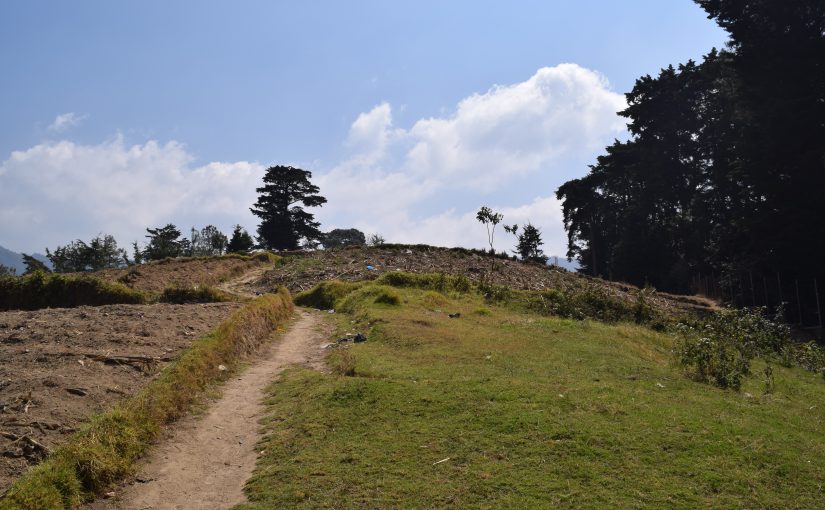As we saw in the previous unit, the direction of actions can be denoted in K’iche’. Verbs can also take on particles that let us know when a verb has a particular direction or movement.
We will take another look at the text from our previous unit, this time focusing on the verbs that have incorporated movement:
UCHUPLINEM JUN ALAJ CH’UMIL
Ronojel chaq’ab’ kinka’y aq’an chi la’ chikaj, kinwil apan jun laj ch’umil sib’alaj kachuplinik; utukelam, le uchuplinem kuya jun nimalaj utzil pa le wanima. K’o jun aq’ab’ xinel apan chwach le wo’ch, xinka’y apan chech le nutinamit, xe’nwil apan jun tzob’aj achijab’-ixoqib’ e petinaq, sib’alaj keb’isonik. Aretaq xeq’ax b’i wuk’, xkib’ij kan chwe cher xeb’e chi na chuch’ab’exik ri nimalaj q’atal tzij, are taq xinta wa’ sib’alaj xinb’isonik, ma we ne kech’ay chu’la jumul ja cha ri uk’isb’al mul.
Alaj ch’umil: we ne aweta’m at ri k’axk’olil kuriq we nutinamit, chaya la jub’eq’ ri uchuplinem ri utzil kariqitaj awuk’, na kawaj ta chik kinwil le e qatat-qanan kakiriq k’ax. Kinwachik’aj ri’ ri jun q’ij cher katkowinik katpe wuk’, arech apachin na k’u kaka’y kan pa le wo’ch: kuna’ b’i jub’eq’ utzil, ki’kotemal. Kawaj pa jun q’ij kinb’e awuk’, kate’nwila’; junam koje’xojowa pa ri k’olb’al ja wi xya wi ri achuplinem. Weta’am cher xa rumal sib’alaj naj ri at k’o wi, we ne na kintzalij ta chu’la pa le nutinamit, cherma we na kintzalij ta chu’loq: oj keb’ chi k’ut kaqaya la le uchuplinem ri utzil, ri ki’kotemal chikech ri achijab’, ri ixoqib’, ri e qatat-qanan, ri qati’t qamam chuqe ne ri ak’alab’ ri kakitzukuj ri utzil; ma ja cha ri at, ja cha ri in, ja cha ri konojel taq winaq, k’is k’o ri uchuplinem ri utzil ri ki’kotemal pa taq ri uk’u’x qanima.
Every night I look to the sky and I see a little star that shines alone. Its brightness give peace to my heart. One night I went outside my house, and I looked to my town. I saw a group of men and women on their way. They were very sad. When they passed by they told me that they were going to see the alcalde. When I heard that I got sad; maybe they had been hurt again like last time.
Little star: maybe you know the suffering of our people. Send some of your brightness, of your peace. I don’t want to see the suffering of our fathers. I dream about that day that you come to me so that anyone who sees my house can feel a bit of peace, of joy. One day I want to go to see you, to dance together in that place where your brightness was given. Maybe, because of how far it is, I won’t return to my town, but if I do not come back, we will both send the brightness of peace, the joy to the men, the women, our parents grandparents and also to the children that seek peace, like you, like me, like all people. They all have the brightness of peace, joy in the depth of their hearts.
K’iche’ verbs often include inserted parts that add a sense of ‘movement’ to the verb action, as in English go (there) to (do), or come (here) to (do). This is called incorporated movement.
I went to see the game three days ago.
The two insertions used (-e’– and –ul-) are derived from the intransitive verbs ul (coming here) and b’e (going there). In Standard K’iche’ –e’- appears as –b’e’.
Verbs that include “movement” use the suffixes as for imperatives.
Intransitive verbs with “movement”:
In intransitive verbs with incorporated movement stress moves from last syllable to penultimate in non-phrase position:
| Non-final: kine’xojówa | Phrase final: kine’xojow-oq |
Transitive verbs with “movement”:
Non-CVC transitive verbs do not show a change in the stem, when movement is incorporated.
CVC transitive verbs with movement use the same stem as the imperative. A glottal stop is added after the final vowel when in phrase final position:
| –V | –V’ |
| Non-final: ke’nwil-a | Phrase final: ke’nwil-a’ |
| CoC > o | CoC > o’ |
| CuC > u | CuC > u’ |
| Ca/e/iC > a | Ca/e/iC > a’ |
Order of elements:
The directional/movement particles are inserted between aspect marker and verb stem. The order of elements (there are exceptions):
Intransitive verbs:
TAM – Set B – MOV – Verb stem – phrase final suffix
Kate’b’inoq
k – at – e’ – b’in – oq
You are going to go walk
Transitive verbs:
TAM – Set B – MOV – Set A – Verb stem
Kojulkitzukuj.
k – oj – ul – ki – tzukuj
They are coming to look for us.
TAM – Set b – MOV – Set A – Verb stem – Ending – Phrase final suffix
k – ø – e’ – in – k’ut – u – ‘
I will go and show/teach it.
Exceptions appear especially for MOV –e’-, because the insertion leads to vowel clusters. In these cases the order of Pronoun and MOV may be switched, weak vowels may be dropped, or –e’– is reduced to an inserted glottal (‘), a process we have already seen elsewhere:
*k-in-e’-uxlanoq
Kinu‘xlanoq
I am going to rest.
Vowel disappears: (weak –i from –inw- disappears)
*k-at-e’-(i)nw –il-a’
I am going to see you.
*k-ix-e’-inw-ila’
I go see you all.
Inserted glottal
*k-e’-uxlana la
You (formal) go to rest
*k-in-e’-aw-ila’
Kina’wila
You go see me.

